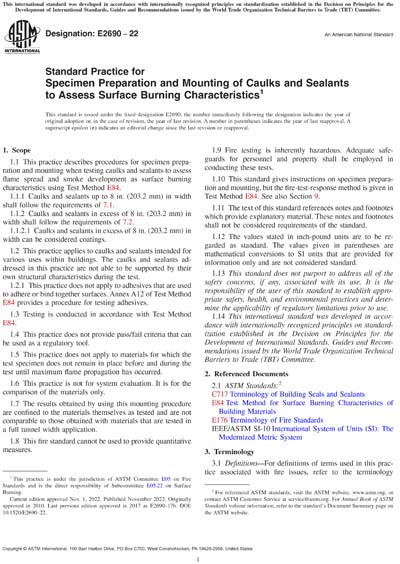Most recent
ASTM E2690-22
Standard Practice for Specimen Preparation and Mounting of Caulks and Sealants to Assess Surface Burning Characteristics
1.1This practice describes procedures for specimen preparation and mounting when testing caulks and sealants to assess flame spread and smoke development as surface burning characteristics using Test Method E84.
1.1.1Caulks and sealants up to 8 in. (203.2 mm) in width shall follow the requirements of 7.1.
1.1.2Caulks and sealants in excess of 8 in. (203.2 mm) in width shall follow the requirements of 7.2.
1.1.2.1Caulks and sealants in excess of 8 in. (203.2 mm) in width can be considered coatings.
1.2This practice applies to caulks and sealants intended for various uses within buildings. The caulks and sealants addressed in this practice are not able to be supported by their own structural characteristics during the test.
1.2.1This practice does not apply to adhesives that are used to adhere or bind together surfaces. Annex A12 of Test Method E84 provides a procedure for testing adhesives.
1.3Testing is conducted in accordance with Test Method E84.
1.4This practice does not provide pass/fail criteria that can be used as a regulatory tool.
1.5This practice does not apply to materials for which the test specimen does not remain in place before and during the test until maximum flame propagation has occurred.
1.6This practice is not for system evaluation. It is for the comparison of the materials only.
1.7The results obtained by using this mounting procedure are confined to the materials themselves as tested and are not comparable to those obtained with materials that are tested in a full tunnel width application.
1.8This fire standard cannot be used to provide quantitative measures.
1.9Fire testing is inherently hazardous. Adequate safeguards for personnel and property shall be employed in conducting these tests.
1.10This standard gives instructions on specimen preparation and mounting, but the fire-test-response method is given in Test Method E84. See also Section 9.
1.11The text of this standard references notes and footnotes which provide explanatory material. These notes and footnotes shall not be considered requirements of the standard.
1.12The values stated in inch-pound units are to be regarded as standard. The values given in parentheses are mathematical conversions to SI units that are provided for information only and are not considered standard.
1.13This standard does not purport to address all of the safety concerns, if any, associated with its use. It is the responsibility of the user of this standard to establish appropriate safety, health, and environmental practices and determine the applicability of regulatory limitations prior to use.
1.14This international standard was developed in accordance with internationally recognized principles on standardization established in the Decision on Principles for the Development of International Standards, Guides and Recommendations issued by the World Trade Organization Technical Barriers to Trade (TBT) Committee.
Content Provider
ASTM International [astm]






